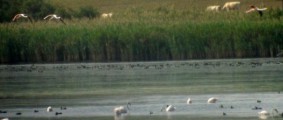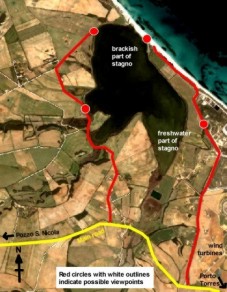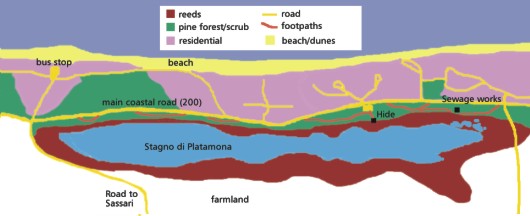|
|
|
|
Birdwatching at Stagno di Pilo |
|
|
The Stagno di Pilo is located west of the town of Porto Torres, near to some large wind turbines recently installed along the coast.† Despite the extensive oil refineries to the east, the stagno is still relatively unpolluted and is an excellent location for birdwatching.† Various streams run into the stagno most of the year round, allowing it to support freshwater species, as well as the large flocks of flamingos which can reach over 100 birds at some times of the year.† Itís relatively unknown, even among local Sardinians, and access to most of the shores and good vantage points for birdwatching is not difficult.† It is one of the best places in the autumn to see migrant species, especially waders.
Notable
species at the Stagno di Pilo are: Resident Great Crested Grebe,
Little Grebe, Flamingo, Marsh Harrier, Buzzard, Kestrel, Peregrine Falcon, Cetti's Warbler, Sardinian
Warbler, Dartford Warbler, Zitting Cisticola, Stonechat, Corn Bunting, Cirl
Bunting Summer Purple Heron, Osprey, Black-winged Stilt, Slender-billed Gull, Bee-eater, Calandra Lark, Woodlark, Nightingale, Yellow Wagtail. I've read reports of Roller being seen here, but have not confirmed them myself. Spring and Autumn Great Egret, Grey Heron, Little Egret, Shoveler, Pintail, Pochard, Gadwall, Osprey, Greenshank, Ringed Plover, Turnstone, Ruff, Redshank, Spotted Redshank, Curlew, Dunlin, Curlew Sandpiper, Common Sandpiper, Snipe, Oystercatcher (rare for Sardinia), Bee-eater, Hoopoe, Whinchat, Redstart. I saw 1 Red-breasted Merganser in Nov. 2006 here. Winter Black-necked Grebe, Grey Heron, Great Egret, Little Egret, Wigeon, Pintail, Shoveler, Pochard, Greenshank, Common Sandpiper, Snipe, Lapwing, Black-headed Gull
Flamingos landing at the Stagno di Pilo Getting to the Stagno di Pilo By car,
from Sassari or Alghero, head north-west, following signs to Stintino.† Part way, youíll arrive in a village
called Pozzo San Nicola.† In this
village take the road that heads east, back towards Porto Torres.† After about 2-3km, the road drops down
into a dip, and the stagno can just be seen to the left.† As it comes up the hill, there is a
turning to the left, just before the huge wind turbines.† Take this turning and follow the road,
keeping left.† The stagno will soon
appear on your left.† After the brow
of a hill, there is a good vantage point by the road to scan the south-east
fork of the stagno with a telescope. †Keep
going down the hill, until the road turns into a dirt track by the sea.† Keep going and youíll reach the seaward
shore of the stagno.† If you are
coming from the centre of Porto Torres (following signs for Stintino), you may
come past the wind turbines on your right, in which case, turn right just
after them.† To reach the western side
of the stagno, come back to the main road, turn right towards Pozzo S. Nicola,
and just after the stream valley, there is a turning to the right, which turns
into a dirt track that will take you along the side of the stagno.† See
the map for places where you can get through to the Stagno di Pilo from this
side. By public
transport, it is difficult to get to Pilo.† From Sassari, there is a bus that runs to Stintino a few times
a day (see page on Stintino for more information).† Youíll need to get off at a small village called Pozzo S.
Nicola, from where itís a 4 kilometre walk to the shores of the stagno!† I recommend getting a printout from Google
Earth before you go if youíre planning to go this way. † |
Click
on the map to open a larger version in a new window: |
|
Birdwatching at Platamona |
|
|
Platamona is a small seaside town with a long sandy beach and lots of lidos just north of Sassari. It has a fairly large Stagno (about 2km long), which is significant because it is freshwater (not brackish, as most of the Stagni in the area are) and it is surrounded by fairly extensive Phragmites reeds, making it, along with the Stagno di Calich near Alghero, one of the few places where a good range of warbler and heron species can be seen, especially in the spring and autumn on migration. It has an excellent tower hide overlooking the best part of the stagno. Main access is from the coastal road to the north of the stagno. As well as the hide, there are plenty of raised mounds in the stone pine forest/scrub that allow good visibility over the reeds, and a small sewage works that attracts insect eaters. There are several car parks and tracks into this strip of forest. Purple Swamp Hen breeds here, although they are quite difficult to see through the extensive reed beds. I recommend looking across from the mounds near the sewage works that overlook the smaller ponds among the reeds. Both Ferruginous Duck and Red-crested Pochard can sometimes be found here, both on passage and during the winter. Throughout the winter a colony of 3,000-5,000 Starlings roost on the reedbeds. The scene at dusk is spectacular as the Starlings fly in to roost, and are regularly dive-bombed by several attendant Peregrine Falcons. Getting to Platamona By car, Platamona is very easy to get to. From Alghero follow the main road to Porto Torres. In Porto Torres take the main road east (signposted Castelsardo or Platamona) and follow the coastal road for 5km east. From Sassari or Cagliari, take the main motorway to Porto Torres (131). After you bypass a small village called San Giovanni, take the next right (brown signpost: Platamona). There are frequent bus
services from Sassari, which depart from Via Tavolara (in the Public
Gardens). They are local buses (yellow) and you can buy tickets at the
kiosk in Via Tavolara. In summer, they depart every 40 minutes or
so. In winter, they are about every 1hr20mins. On the front look
for 'MP - Marina di Platamona' or 'BB - Budi Budi'. Both go to
Platamona. The trip takes about 30 minutes. The Budi Budi bus is
best for the east end of the stagno, where the hide and the sewage works
are. Get off at the next stop after the bus passes over the reed
beds. The Marina di Platamona bus stops at the west end of the
stagno. Get off at the seafront car park, and walk back along the
approach road to the western end of the stagno. Both buses depart first
from the seafront 'bus stop' marked on the map above. Beware in the
summer, late afternoon and evening buses can be packed with the Sassaresi
going back home after a day on the beach, and may not stop further along if
they are full. So it's best to get on at the beachfront bus stop.
The Stagno di Platamona from the tower hide
|
Notable species at the Stagno di Platamona are:
Resident Great Crested Grebe, Little Grebe, Cattle Egret (roost on marshes), Purple Swamp Hen, Water Rail, Mallard, Shoveler, Marsh Harrier, Buzzard, Kentish Plover (occasional on the beach), Audouin's Gull (see note below), Scop's Owl, Great Spotted Woodpecker, Cetti's Warbler, Sardinian Warbler, Zitting Cisticola, Serin, Stonechat
Summer Purple Heron (a good site for this species; easy to see), Little Bittern, Reed Warbler, Spotted Flycatcher
Spring and Autumn Squacco Heron, Grey Heron, Little Egret, Ferruginous Duck, Pintail, Garganey, Teal, Red-crested Pochard, Pochard, Little Stint, Common Sandpiper, House and Sand Martin, Alpine Swift, Bee-eater Great Reed Warbler, Spotted Flycatcher
Winter Grey Heron, Great Egret, Little Egret, Ferruginous Duck, Red-crested Pochard, Pochard, Teal, Wigeon, Lapwing, Peregrine Falcon, Black-headed Gull, Chiff Chaff, Black Redstart
Audouin's Gull Having scoured all the colonies of Yellow-legged Gull on the rocky islands on the N.W. coast of Sardinia in search of Audouin's Gull all winter without any luck, I was surprised to find my first Audouin's Gull scavenging along the beach in the spring at Platamona! The vast majority of the gulls here are Yellow-legged, but regular Audouin's Gulls do roam along the beach, mainly in the summer. The only place in the N.W. where they nest in good numbers (as far as I know) is on some rocky islets in a sheltered bay on the Island of Asinara. The individuals that come down to Platamona might be from this colony.
|




